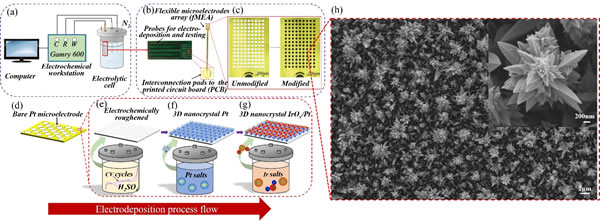Recently, Wu Tianzhun, a researcher at the Micro-nano Center of the Institute of Medical Technology, Shenzhen Institute of Advanced Technology, Chinese Academy of Sciences and his research team have successfully developed a high-performance, controllable three-dimensional iridium oxide / platinum nanocomposite used to modify nerve microelectrodes. Record electrical performance. Related research results Well Controlled 3D Iridium Oxide / Platinum Nanocomposites with Greatly Enhanced Electrochemical Performances ("Three-dimensional Iridium Oxide / Platinum Nanocomposites with good controllable and extremely strong electrochemical performance") have been published online in "Advanced Materials Interface" Interfaces, DOI: 10.1002 / admi.201900356). The first author of the paper is assistant researcher Zeng Qi, and the corresponding author is Wu Tianzhun.
In recent years, with the rapid development of miniaturized and flexible electronic devices and portable, wearable, and implantable, the demand for miniature energy storage devices is also increasing. Among them, miniaturized electrochemical capacitors (Electrochemical capacitors, ECs) can reach extremely high energy storage density. As typical miniature ECs, nerve electrodes are widely used in neural prostheses such as cochlear implants, artificial retinas, and brain stimulators. Micrometer-scale electrode arrays can provide higher electrical stimulation / recording efficiency for clinics. However, a significant reduction in the size of the electrode will cause a great interface impedance, which seriously reduces the performance of charge storage and injection capabilities, which limits its application. At present, without increasing the electrode geometry, the coatings obtained by the microelectrode surface modification method cannot meet the indicators of low impedance, high charge storage capacity, high charge injection capacity, and long-term stability.
Based on the above considerations, Wu Tianzhun and his team members Zeng Qi and others have successfully developed an iridium oxide / platinum nano-cone composite coating (Electrochimica Acta, 2017, 237, 152-159) in the previous work, which has effectively improved the electrode electrical Performance and stimulation efficiency. The research team further developed the 3D platinum nanoflower structure on the basis of the previous platinum nanocones and explored its evolution; at the same time, the obtained iridium oxide nanoparticles can be well attached to the platinum nanostructures.
The results of the study showed that after the modification of the high-performance 3D iridium oxide / platinum nanocomposite on the surface of the microelectrode (electrode diameter: 200 μm), the electrochemical impedance was reduced by 94.52% compared with the unmodified electrode, and the cathode charge storage capacity increased by more than 56 times ( 1 order of magnitude higher than the previous work). After more than 100 million continuous electrical pulse stimulation, the electrode modified by the composite material still maintains the cathode charge storage capacity above 86%. In addition, its charge injection capability is as high as 6.37 mC · cm-2, far ahead of the currently reported platinum / iridium nerve electrode modification materials; it also exhibits excellent specificity and sensitivity in glucose detection. The research results effectively solve the existing shortcomings in technology, strong operability, and can be mass-produced. It has important guiding significance for the development of micro-electrode surface modification materials and nerve electrode stimulation / recording represented by artificial retinas, and is expected to be widely used. In the fields of neural prosthesis, high-efficiency stimulation / recording electrodes, biosensing, energy storage, etc.
The above research was supported by the National Natural Science Foundation of China, Guangdong Natural Science Foundation, and Shenzhen Peacock Team Project.

(A) Schematic diagram of electrochemical modification device; (b) Arrangement of microelectrode array; (c) Optical microscopic images before and after modification of microelectrode surface; (d)-(g) Flow chart of microelectrode surface modification; (h) Oxidation Microstructure of iridium / platinum nanomaterials
Pq-6 For Hair Care Products,Pq-6 For Skin Care Products,Polyquaternium-6 Pq-6 Cas No.26062-79-3,Polyquaternium-6 Pq-6 For Hair Care
ZHEJIANG XINHAITIAN BIO-TECHNOLOGY CO.,LTD. , https://www.dadmacxht.com